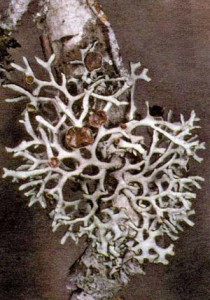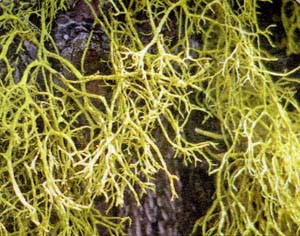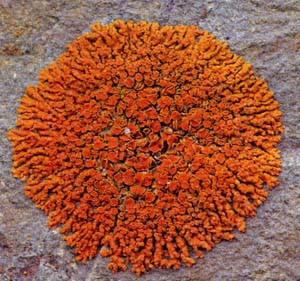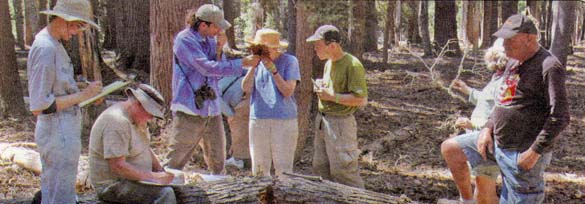Lichen Survey Hits the Jackpot One-Day “BioBlitz” Uncovers 61 Species Not Previously Recorded at Crater Lake
Reflections Visitor Guide
Crater Lake National Park
Summer/Fall 2009
National Park Service
We’ve all seen lichens-they’re everywhere. They grow on tree trunks, branches, cliffs, boulders, and even buildings. They come in a rainbow of colors and a myriad of forms. Yet, despite their beauty and ubiquity, their small stature means they’re often overlooked-even in national parks.
|
Letharia vulpina “Staghorn” or “Wolf Lichen” |
|
Xanthoria elegans “Elegant Sunburst Lichen” |

Hypogymnia imshaugii “Forked Tube Lichen” |
In the summer of 2008, however, 3 lichen experts and 39 volunteers teamed up for a one-day Lichen BioBlitz at Crater Lake National Park to raise awareness of these fascinating organisms arid to catalogue their diversity. On August 23rd, in the course of a 7-hour survey, the investigators nearly doubled the number of lichen species recorded in the park.
A “BioBlitz” is a quick assessment of the number of living things (or a subset of living things) in a particular place. It’s not a complete inventory, but it does indicate the degree of biodiversity in a given area. BioBlitzes provide valuable baseline data and help lay the groundwork for further studies. By enlisting the help of the general public, BioBlitzes also provide opportunities for laypeople to make scientific discoveries and to interact with professional biologists.
Five sampling sites, representing a range of habitats, were chosen for the Lichen BioBlitz: lower Annie Creek, upper Annie Creek, Godfrey Glen, Castle Crest, and Cloudcap. At each site, volunteers collected lichen samples and brought them to a central location, where a lichenologist made preliminary identifications.
Prior to the survey, 64 lichen species had been documented in the park. Remarkably, the BioBlitz volunteers uncovered 61 additional species, bringing the lichen biodiversity list for Crater Lake to 125 species. Based on the day’s findings, lichenologist Rick Demmer predicted that “If we could come back here with more time and check out other kinds of habitat, I suspect the total could nearly be doubled again.”
It’s useful to know which lichens inhabit an area because of their potential as bioindicators. Although lichens are among the hardiest of organisms, capable of living in extreme environments ranging from arctic tundra to desert sand, they a sensitive to environmental pollutants. Keeping tabs on the health of our lichens can help us gauge the health of our park, as well as our planet.
Lichens are also valuable for other reasons: they stabilize the soil, provide food for animals, and furnish nesting material for birds. Even though many lichens grow on trees, they are not parasitic. They derive moisture and nutrients from the atmosphere and produce their own food through photosynthesis.
But don’t be fooled-lichens aren’t exactly plants. They are composite organisms, made up of several species that live and work together in a symbiotic (mutually beneficial) relationship. Typically, the union is between a fungus and an alga. The fungus provides structure and protection for the alga; the alga manufactures food for the fungus.
It’s a successful partnership-much like the one between BioBlitz biologists and volunteers. Biologists provide the expertise needed for species identification; volunteers provide the manpower needed to canvass a large area in a short amount of time.
The 2008 Lichen BioBlitz was sponsored by the park’s Science and Learning Center. The center also organized the park’s first BioBlitz, a 2007 plant survey of Sphagnum Bog, a wetland on the western edge of the park. The park’s next BioBlitz is scheduled for 2010. Check the park’s website (www.nps.gov/crla/slc.htm) in the summer of 2010 for information on volunteering.
In the meantime, as you walk through the park this summer, take a moment to notice and appreciate the varied assortment of lichens-hidden in plain sight-on the cliffs, tree trunks, branches, buildings, and rocks beneath your feet.




